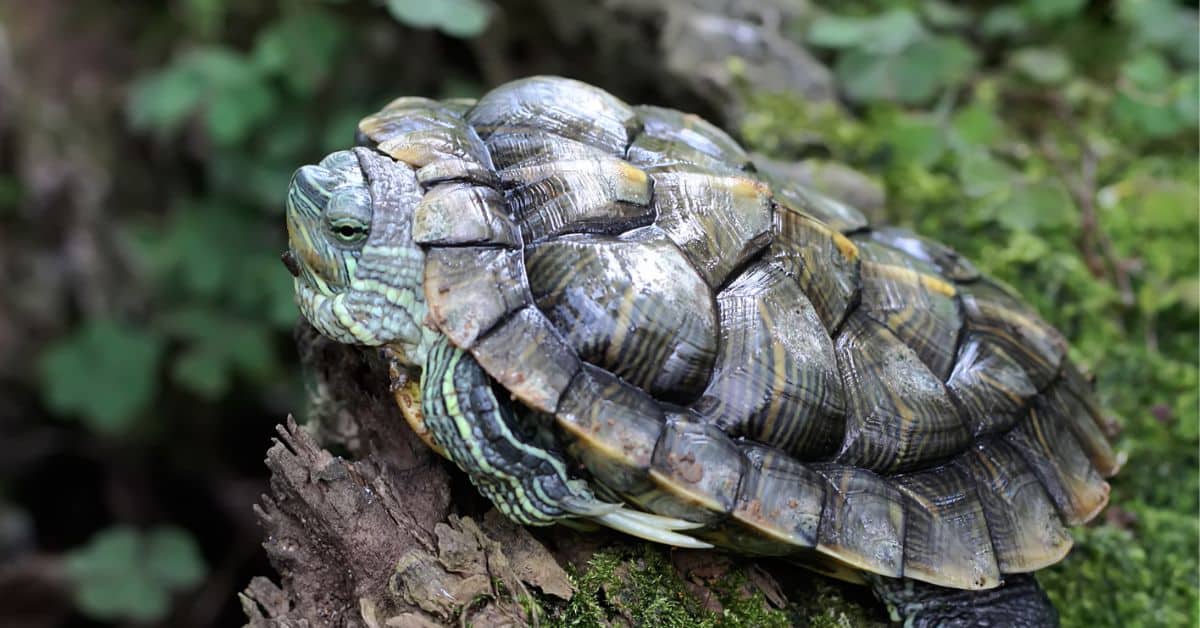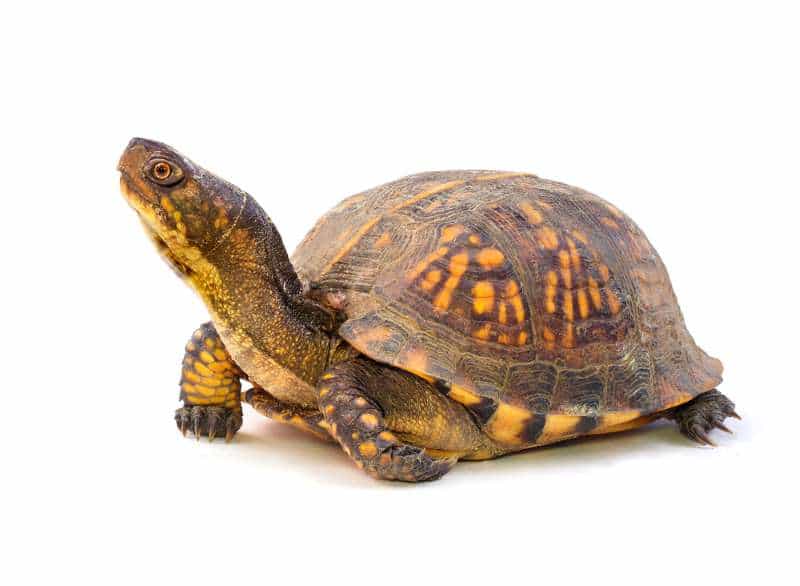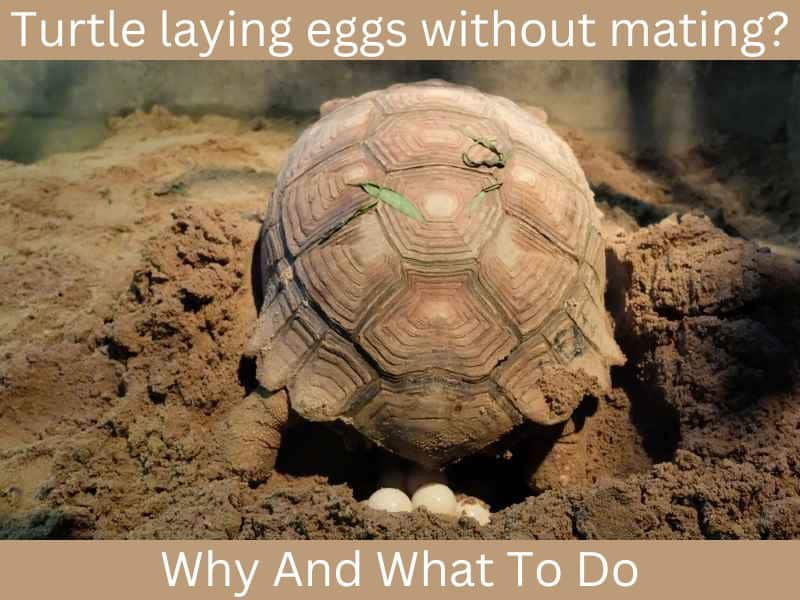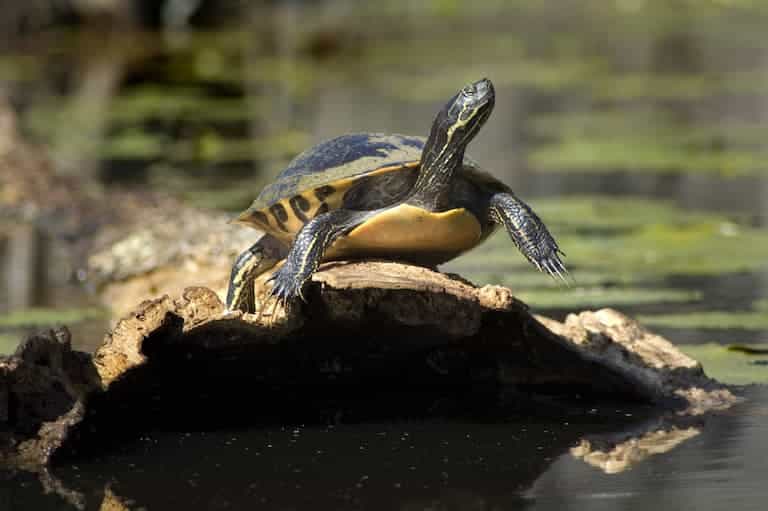Unhealthy Turtle Shell Problems: Healing & Prevention (Complete List)

It can be challenging to identify issues with your pet turtle. Luckily, the discoloration and feel of a turtle shell can be a clear giveaway of your red-eared slider’s health.
Most red-eared slider shell problems occur because of poor care. Lack of filtration, dirty water, and inadequate diet can lead to extreme health issues, like shell rot, cracked shells, and more.
Continue reading this article to have all your types of red-eared slider shell turtle shell problems answered, including what a healthy red-eared slider shell looks like and how to identify a variety of different slider shell problems.
Contents
What does a healthy turtle shell look like
Red-eared slider shells should be smooth, ovular, and shiny. They are usually dark green and black with white or light yellow tints.
Feel your turtle’s shell for any texture issues, like softness (which can signify major illness). When you touch the surface of the shell, it should be hard and free of any chips, cracks, or dents. You should also observe your tank for any pieces of shell that might have fallen off your shell.
How to take care of your slider’s shell for prevention
Turtle shells are made of keratin. Therefore, they require regular brushing to remove dirt. Otherwise, your turtle may face severe skin irritation. Forgetting to brush your turtle’s shell can cause mineral deposits, algae growth, and infections.
How to clean your red eared sliders shell
The best way to clean your turtle is to use a soft-bristled brush from a pet store. You may also use a soft toothbrush from your local grocery store.
You must clean your turtle’s shell frequently to keep it healthy.
What about a cracked turtle shell
A crack in your turtle’s shell is a sign of injury. Shells are a part of the turtle’s skeleton, making it essential to treat these injuries when you notice them. If you do not treat these injuries, your turtle may get infected.
Causes for a cracked shell
Bacteria in your tank can cause your turtle’s shell to crack. Although some bacteria can form on the outside of your turtle’s shell, most bacteria will rest on the inside of your turtle’s shell and cause it to crack from the inside out.
If you have multiple turtles in your tank, cracks may develop in their shells because they are fighting each other.
Treatment for a cracked shell
Cracks less than a quarter inch can be treated at home with hydrogen peroxide, topical ointment, and bandages. On the other hand, large gashes larger than a quarter inch long should be treated by a veterinarian since they can be a sign of serious injury.
While treating your turtle’s shell, keep them dry and away from other turtles. It is also important to keep them away from heights and other animals.
Prevention for a cracked shell
Maintain a clean tank to prevent your turtle’s shell from cracking or falling off. Provide them with good water quality, including proper PH levels and a functioning filtration system. In addition, there should be at least one basking spot for your turtle to emerge fully from the water.
Keeping one or more turtles in the same tank can lead to aggressive behavior, especially if they are mature males. Therefore, you should avoid keeping several turtles in the tank together. If you want to own multiple turtles, keep them in separate tanks, or one larger tank.
What if there is a hole in my turtle’s shell
A hole in your turtle’s shell can be one of the most intimidating issues since its shell is a part of its skeletal system. Although it can take years to return to normal, there are ways that you can assist in repairing these holes and get your turtle back to normal.
Causes for the hole in your turtles shell
Holes in your turtle shell are not always a sign of major illness or injury. It can signify that your turtle is experiencing dietary neglect, such as vitamin or nutrient deficiency.
In more serious cases, a hole in your turtle’s shell is a dangerous sign that your turtle is experiencing illness or disease. In either case, if you notice a hole in your turtle’s shell, you should address the problem immediately.
Additionally, keeping multiple turtles in your tank can lead to aggressive behavior. Aggressive behavior means your turtle can create holes in your turtle’s shell.
Treatment for the turtles shell hole
If there is a hole in your red-eared slider’s shell, you can cover the hole with a fiberglass patch. The fiberglass patch will cover the hole in the shell and prevent any water or bacteria from entering the shell. Attach the fiberglass patch using glue.
After applying a fiberglass patch, cover it with clear resin. The clear resin will secure the fiberglass patch in place and allow your turtle to return to the water.
It is critical that you do not let your turtle’s shell get wet when they have a hole in its shell. Otherwise, the hole may get infected. Keep them out of the water for several days on a clean, dry surface until they are entirely dry.
After it is dry, they can return their tank. Unfortunately, it can take several years for your turtle’s shell to heal fully. If it does not show any sign of healing, you may want to take your turtle to the veterinarian for an evaluation.
How to prevent your turtle from getting a hole in their shell
Prevent your red-eared slider from getting holes in its shell by providing a safe and clean environment.
Avoid placing two turtles in the same tank to avoid aggression. Placing multiple turtles in your tank together can lead to fighting.
My red-eared slider turtle seems to have a soft shell
While some turtles naturally have soft shells, it is not typical for a red-eared slider to have a soft shell. If your red-nosed slider has a soft shell, it could be a sign of metabolic bone disease, which could become fatal if untreated.
Additionally, a soft turtle shell could signify shell rot. Like a metabolic bone disease, shell rot can become fatal if you do not treat it promptly.
In most cases, your turtle’s shell will feel soft around the edges, but it may also feel soft on the top of its shell, depending on how severe the disease has become.
Causes of a soft shell
A soft turtle shell is typically caused by an unbalanced diet, including calcium deficiency. Calcium deficiency is a leading cause of metabolic bone, which is dangerous because it can be fatal if untreated.
In addition to a poor diet, lack of UV lighting is another leading cause of metabolic bone disease or shell rot. In many cases, owners have not provided proper basking platforms, which leads to inadequate light exposure.
Treatment for a soft shell
If your turtle has a soft shell, take them to your veterinarian for a proper diagnosis. They will provide you with supplements or medication to treat issues like metabolic bone disease.
Your veterinarian may also recommend that you provide your turtle with vitamin and mineral supplements to support a healthy diet. If they are suffering from a bone disease, you may need to increase the amount of calcium in their diet by adding an additional calcium supplement to their daily feeding routine.
Prevention for a soft shell
To maintain the integrity of your turtle’s shell, feed it a proper diet full of vitamins and nutrients. The primary diet for a hard and healthy shell is plenty of calcium. You can give your turtle calcium supplements or fresh foods like kale or other green, leafy vegetables. The occasional feeder fish, like crayfish, can be another fantastic source of calcium for red-eared slider turtles.
Provide your turtle with an adequate basking platform to ensure they get enough light daily. Basking platforms allow your turtle to escape the water so they can dry themselves and soak in real or artificial lighting.
Shell Pyramiding Issues
Shell pyramiding is an illness that may occur because of diet or environment. The disease causes each scute to grow excessively upward in a pyramid shape. Although it is relatively uncommon for the red-eared slider, it can still happen when their owners do not provide them with proper care.
Causes of pyramiding shells in red eared slider turtles
Typically, shell pyramiding is caused by calcium or vitamin deficiency. In addition, it may also be caused by an insufficient environment, such as poor water conditions or inadequate tank temperature.
Treatment of pyramiding shells in red eared sliders
Unfortunately, you cannot reverse the effects of shell pyramiding once it has begun. However, you can add a vitamin supplement to your turtle’s diet to ensure it does not continue upward growth.
If a poor environment is the leading cause of your turtle’s shell pyramiding, test the water quality. You may need to adjust the temperature or pH of your water. After adjusting your water quality, you can prevent further growth.
Prevention for pyramiding
To prevent shell pyramiding, feed your turtle a healthy diet full of vitamins and minerals. One of the most important minerals for your turtle is calcium. Calcium in your turtle’s diet will keep your turtle’s shell strong and healthy.
In addition to supplying a proper diet, you should ensure your red-eared slider has an adequate environment with good water quality. Frequently check your turtle’s water quality to ensure it remains sustainable.
Red eared sliders shell is flat
The ideal red-eared slider shell should be dome-shaped. So, when you see it begin to flatten, it could be a sign they are developing a serious illness like shell rot or calcium deficiency.
Causes for a flattening shell
Most instances of shell flattening are caused by severe vitamin and nutrient deficiency.
Treatment for a flattened slider shell
Visit your veterinarian for a proper diagnosis if you notice a physical deformation.
Prevention for a flat red eared slider shell
Feed your red-eared slider a healthy diet, including an abundance of nutrient-filled vegetables to prevent shell flattening.
Discoloration of your red eared slider shell
Discoloration is one of the most common problems for red-eared sliders. However, not all forms of discoloration should alarm you. In fact, some discoloration can be a good sign of a healthy turtle.
White shell Discoloration
A white shell is common for many red-eared slider turtles, which are not kept in a hospitable living environment. It can signify that your turtle has a fungal infection or has had too much sun exposure.
Causes for a white shell discoloration
The most likely cause of white spots is fungal or bacterial infections. These infections are often caused by an unclean environment, like dirty water and poor filtration.
A white shell may indicate that your turtle has received too much UV lighting exposure.
Treatment for white discoloration
First, you should clean around the infected area with soap and warm water, then apply a fungal cream to the infected area. Repeat this process several times per week for several weeks. If you do not notice any improvement, you should take your turtle to the vet for further treatment.
Unfortunately, if your turtle has endured sun bleaching, there is nothing you can do to reverse the effects. Sun bleaching is a permanent problem that will last on your turtle.
Prevention of white/fungal discoloration
Regular cleaning is the only way to prevent bacterial infections from forming on your red-eared slider’s shell. Clean your turtle’s tank regularly and use a soft toothbrush or a pet store brush to clean your turtle’s shell at least once per week.
Furthermore, a pet-approved sunscreen is one of the best ways to prevent white spots caused by UV lighting. Similar to humans, this preventative measure will keep your turtle from becoming sun-bleached.
Green shell discoloration on your red-eared slider
In most cases, green is the natural color of your turtle’s shell. However, unusual green spots on your turtle’s shell could mean green algae are growing on its shell.
Although green algae grow naturally underwater, it can signify that you need to regularly clean your tank. Green algae on your turtle’s shell may also be a sign that you need to put a filter in your turtle’s tank. Filters typically prevent algae from forming in your tank.
Green algae can be removed by cleaning. Take a soft-bristle brush from your pet store (or a toothbrush) and gently scrub away the algae using a pet-safe disinfectant.
Black shell discoloration on your red-eared slider
A turtle’s shell should naturally be black. However, the appearance of unusual black spots can signify that your turtle is experiencing molding on their shell.
Molding and mildew mean your turtle has inadequate space to escape the water. Turtles like to spend several hours outside of the water drying themselves . Check their tank and confirm they have enough space to escape the water and bask.
If you do not have enough space for them to escape the water, try rearranging their tank and inserting a decorative piece for them to lay on.
Brown shell discoloration on your red-eared slider
Brown spots accompany natural shedding. They are nothing to worry about as long as your water is clean and your turtle appears healthy. Never try removing your turtle’s skin yourself.
Yellow shell discoloration on your red-eared slider
Similar to brown spots, yellow spots on your turtle’s shell can symbolize shedding. Shedding is a natural process that every turtle goes through and is nothing to worry about.
Red shell discoloration on your red-eared slider
A red spot on your turtle’s shell could be a dangerous sign they are experiencing a bacterial infection like shell rot. Typically, red spots are wet, sticky, and pus-filled. If you notice any red spots on their shell that appear pus-filled, take them to the vet immediately for treatment.
Red-eared slider shell rot
Shell rot is a lethal illness affecting red-eared turtles in poor living conditions. It looks similar to shedding since it causes your turtle to lose dead tissue. However, unlike shedding, your turtle will not regrow new skin after losing its dead tissue.
Causes of shell rot
in most cases, shell rot occurs when you keep your red-eared turtle in unhealthy living conditions, like unclean water or a tank with poor filtration.
In addition to poor water quality, turtles can experience shell rot because they do not have dry space to lay. These inadequate living conditions cause their shells to pick up water contaminants, which lead to molding.
Finally, shell rot may also occur if you feed your turtle a poor diet. A lack of fresh vegetables is typically a leading cause of shell rot since your turtle does not receive the necessary vitamins and nutrients needed to sustain a hard and healthy shell.
Treatment for shell rot
If you suspect your turtle is experiencing shell rot, you should take them to the vet immediately. They will probably recommend you begin by cleaning the wound to remove any infected, dead tissue and then use an antibiotic ointment to heal the wound. If the shell rot has become severe, they may prescribe antibiotics.
Preventing of shell rot on your slider
To prevent shell rot, you must keep your turtle in good living conditions and feed them a diet of fresh vegetables. Change their water frequently and provide them with adequate filtration. To ensure your turtle has proper living conditions, you must provide it with enough land space to escape the water and dry itself.
Is shell rot contagious?
Shell rot is a highly contagious disease that can be easily transmitted from one turtle to another. Therefore, you must treat it immediately to prevent spreading. Unfortunately, since poor living conditions typically cause shell rot, it will likely affect multiple turtles at once.
How to be sure they have shell rot
You can identify shell rot by its discoloration caused by fungal infections. While it is common for turtle shells to discolor as they age, shell rot causes intense red and white colors as it flakes away. It will also create an intense stench and discharge from the shell.
About Spots on or under your red eared sliders shell shell
Spots on your turtle’s shell can signify they are experiencing a major illness or disease, such as shell rot. On the other hand, it can be a natural cause like mineral deposits or shedding, which are not worrisome.
Causes of spots on the shell
The leading cause of mineral deposits is an unclean environment. This unclean environment typically comes from a lack of filtration and forgetting to clean your turtle.
Shedding occurs naturally as your turtle grows or because of overwhelming bacteria.
Treatment for spots on their shell
If your turtle has mineral deposits, gently brush its shell with a soft-bristled brush. Brushing regularly will remove its mineral deposits.
Prevention of spots on their shell
You can prevent some instances of spots on your turtle’s shell by maintaining a clean tank. Clean your tank frequently, change the water regularly, and purchase an adequate filtration system to ensure the water does not become stagnant.
To prevent mineral deposits from forming on your turtle, gently scrub your turtle’s shell with a soft-bristle brush. A gentle scrub will keep bacteria and grime from building up on the surface of your turtle’s shell.
About red-eared slider shell peeling
Shell peeling is a common symptom of shedding, which is entirely normal for any healthy turtle. Turtles frequently shed, preventing infection or bacterial build-up.
Treatment for shell peeling
There is no reason to treat your turtle’s shedding. Shedding occurs naturally as your turtle grows. However, if you notice your turtle’s shell is pre-maturely peeling, it could indicate there are bacteria in its tank.
You may need to clean their tank and start brushing their shell more frequently. Keep in mind that you should never brush their shell when it is peeling.
Swollen red eared slider shell
Keep a close eye on your turtle to observe physical changes, like swelling. Swelling can indicate your turtle has a serious fracture or other major issues.
If your turtle is pregnant, it might mean they are suffering a major medical complication, like dystocia.
Causes of swelling in red eared slider shells
The most common reason a turtle gets a swollen shell is because of shell damage, such as cracks or holes in shells. Shell fractures cause your turtle’s shell to protrude, making them appear thicker than usual. In most cases, you can treat this by bandaging your turtle.
If your turtle has dystocia, it means it cannot lay its eggs, which can be fatal. This is typically caused by a poor environment, malnutrition, or oversized eggs.
Treatment for swelling shells
Treatment for your turtle’s swelling may vary depending on the underlying issue.
Since fracturing is the most common cause of swollen shells, you can fix them with an at-home treatment. For more severe fractures, you may need to take your red-eared slider to the vet.
If you believe your pregnant turtle might be suffering from dystocia, you will need surgical intervention by a medical professional.
Preventing a shell fracture
You can prevent most swollen shell issues by intervening before they face injury. Providing them with a nutrient and vitamin-filled diet will keep them healthy and prevent any shell injuries or birthing issues.
Bleeding red eared slider shell
If you notice your turtle is bleeding, it can signify a major illness. Bleeding shells might indicate a bacterial or fungal infection. Also, bleeding shells can signify nutrient deficiency, burn, or trauma.
Causes for bleeding
Typically, bleeding shells indicate bacterial or fungal infections caused by poor water conditions. If your turtle does not have enough vitamin A in their diet, they are likely to experience hypovitaminosis (a vitamin deficiency).
Treatment for bleeding shell
Treat your red-eared slider’s bleeding shell by cleaning your turtle’s tank and limiting the amount of UV light exposure your turtle gets. If they are experiencing a fungal disease, you may need to clean your turtle’s shell and cover the infected area with fungal cream.
Preventing a bleeding shell
Maintain a clean tank if you want to prevent fungal infections. Furthermore, you must prevent overwhelming UV lighting and heat. Otherwise, your turtle will likely get burns which can lead to sun scorching and bleeding.




